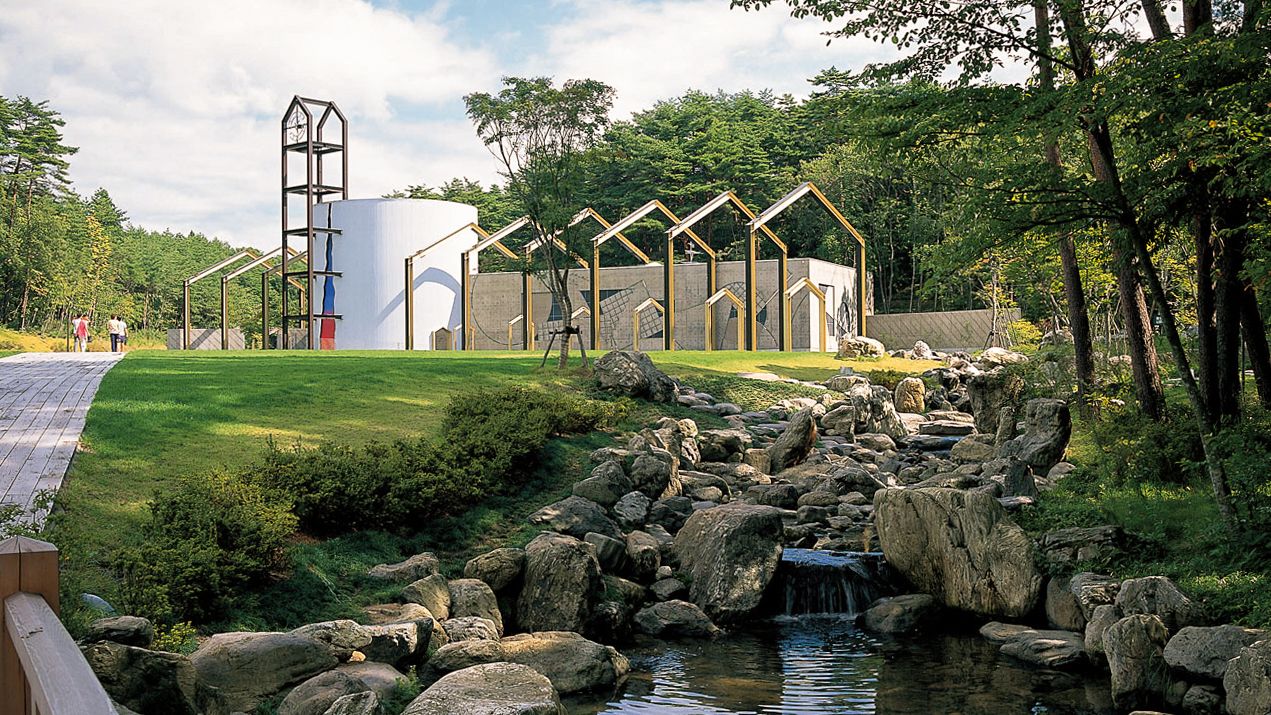
New Perspectives on Miyazawa Kenji
Finding Miyazawa Kenji’s World in His Hometown
Guideto Japan
Travel- English
- 日本語
- 简体字
- 繁體字
- Français
- Español
- العربية
- Русский
Miyazawa Kenji Memorial Museum: Showcasing a Gifted Life
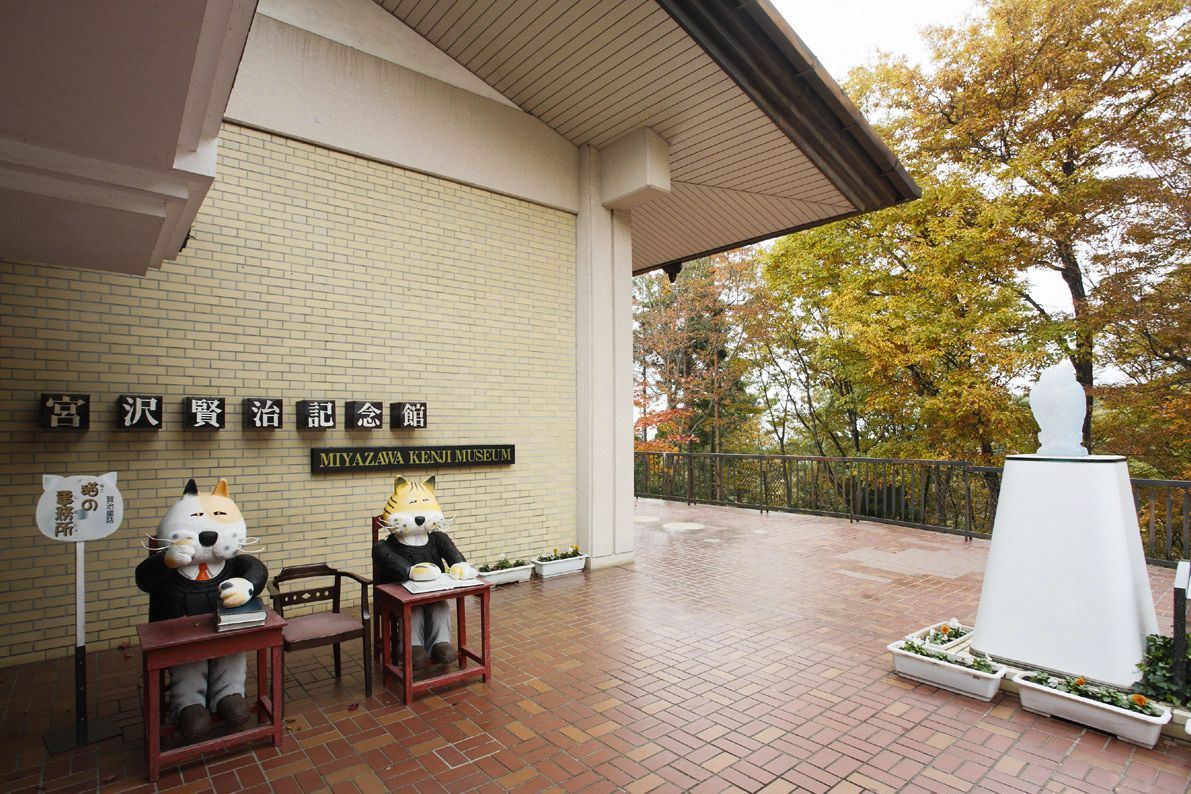
Monuments based on the children’s story “The Cat’s Office” mark the entrance to the Miyazawa Kenji Memorial Museum. (Courtesy of the Iwate Tourism Association)
Born in the city of Hanamaki, Iwate Prefecture, Miyazawa Kenji (1896–1933) is revered by local residents to this day for his many accomplishments. Born into a merchant family, he instead devoted himself to agricultural development in the area where he lived. He studied agriculture in school, eventually teaching at an agricultural high school, as well as tilling the fields himself. At the same time, he also demonstrated talents in fine art, literature, and science. Children’s stories and poetry written by Miyazawa including the novel Ginga tetsudō no yoru (Night on the Galactic Railroad) and his celebrated poem “Ame ni mo makezu” (“Undefeated by the Rain”) are widely admired even today.
Related article › Miyazawa Kenji: A Literary Life in Northern Japan

This cobblestone path leads to the Miyazawa Kenji Memorial Museum. (Courtesy of the Iwate Tourism Association)
Located in the Yasawa district of the city of Hanamaki, the Miyazawa Kenji Memorial Museum sits on the slopes of Koshiōzan, a hill not far from Shin-Hanamaki Station on the Tōhoku Shinkansen. This station itself is only two minutes from Miyazawa Kenji Kinen-kan-guchi, the bus stop nearest to the museum. From this point, however, one must either walk up a flight of 367 stairs, or else take a steep path 500 meters long, to get to the parking lot near the gates of the museum itself. The aforementioned poem, “Ame ni mo makezu,” is rendered one Japanese character after another alongside these elegant carved wood stairs, and reading it as one ascends helps to alleviate the trial at least a little. There are also markers indicating the halfway point and other degrees of progress, and tourists call out “Hello” and “Almost there” in a friendly manner to one another as they pass by. Even so, walking either of these routes is not recommended for persons unsure of their strength. Various monuments based on Miyazawa’s works have been installed in the woods surrounding the museum for visitors to find as well.
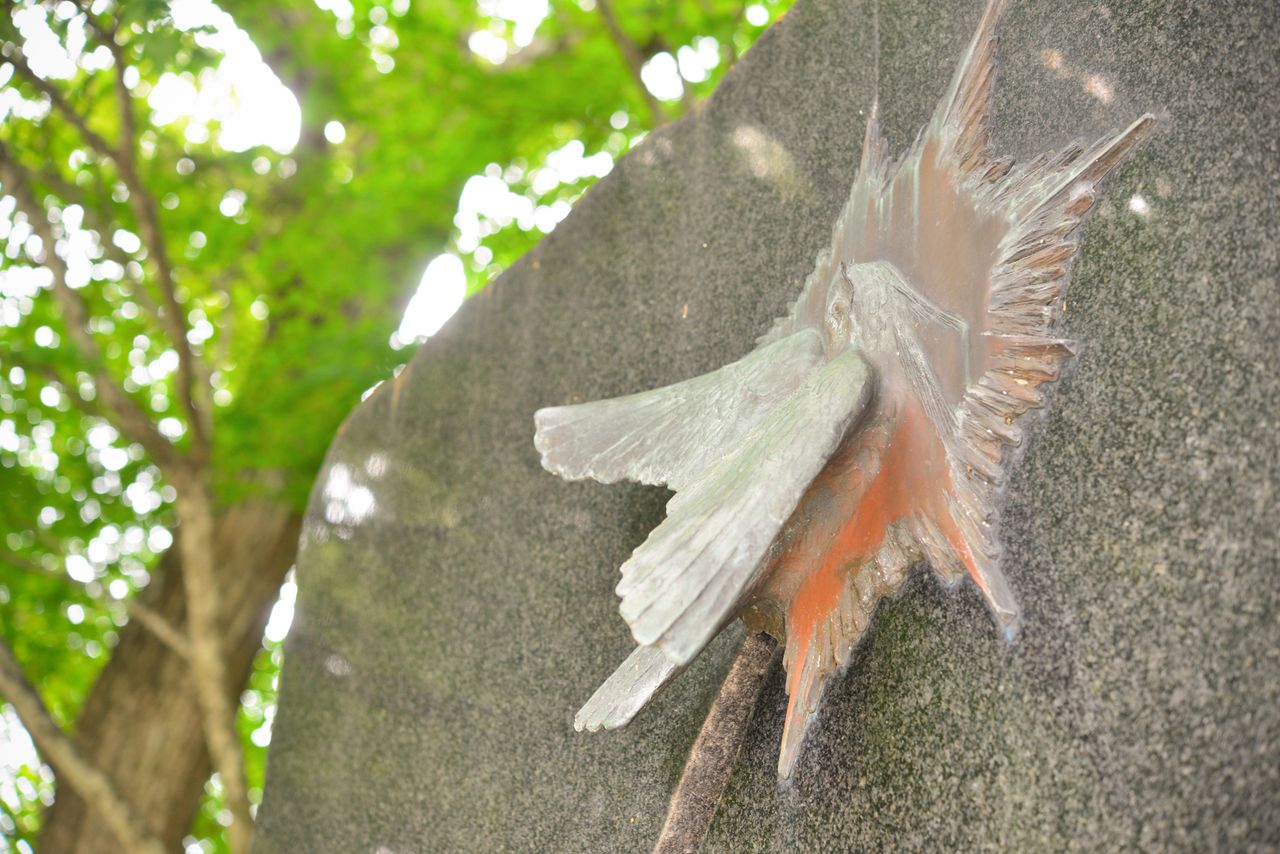
This monument represents a yodaka (nighthawk) who burns as a star, inspired by the Miyazawa Kenji children’s story “Yodaka no hoshi” (“The Nighthawk Star”).
The museum presents Miyazawa’s original manuscripts, personal belongings, publications, and research findings, sorted into five sections corresponding to spheres of his interest: science, fine art, the cosmos, religion, and agriculture. The screen in the center of the floor shows videos about Miyazawa’s ideas, as well as his research and creative endeavors, regarding these fields.
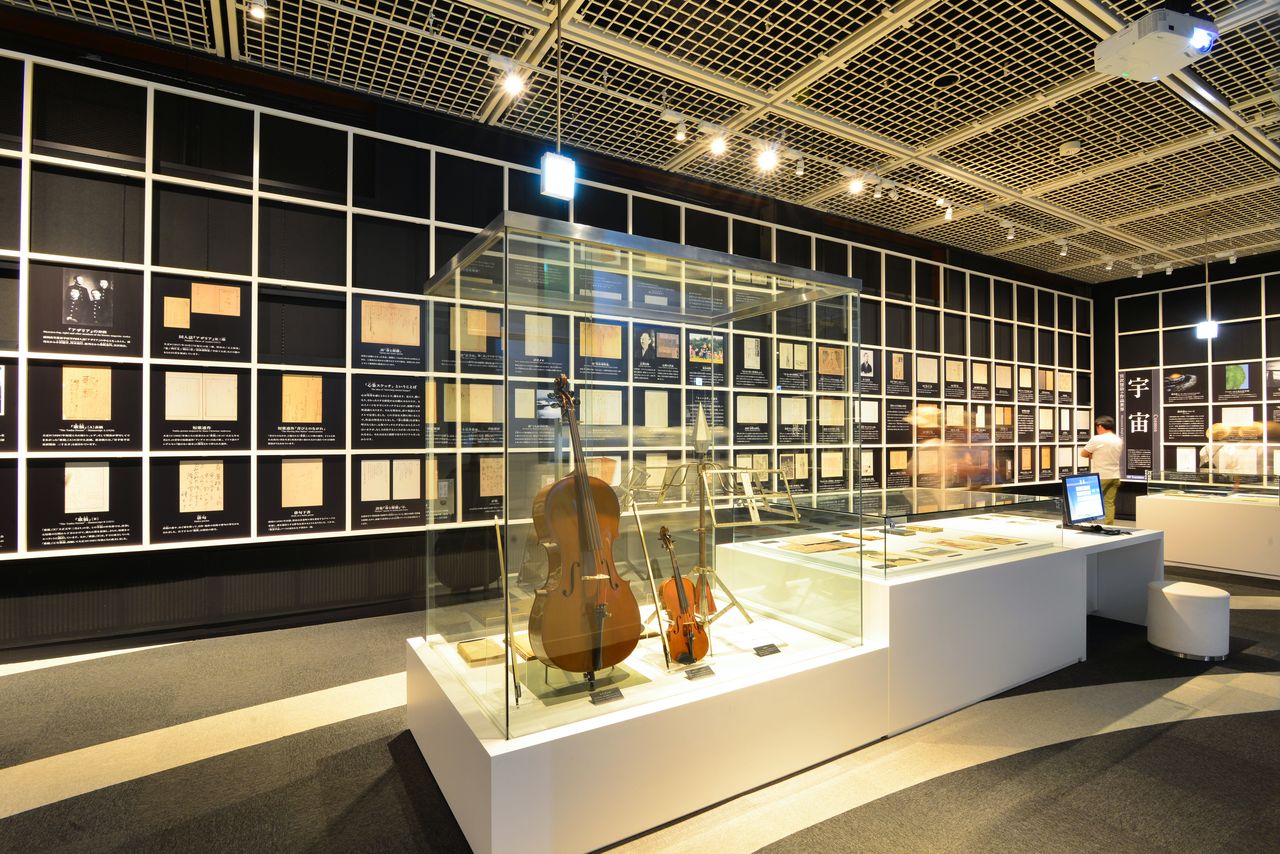
This display shows Miyazawa’s cello next to the violin used by his younger sister, Toshi.
The Kenji Salon near the lobby offers libraries of video and music based on Miyazawa’s works. Examining them after seeing the museum exhibits can give one a renewed sense of how strongly his life experiences and research influenced his creative efforts. Highly recommended.
DATA
Miyazawa Kenji Memorial Museum
- Address: 1-1-36 Yasawa, Hanamaki, Iwate Prefecture
- Access: 2 minutes from JR Shin-Hanamaki Station by Iwateken-kōtsū bus Tsuchisawa line, then 10 minutes on foot from Miyazawa-Kenji-Kinenkan-guchi bus stop
- Tel.: 0198-31-2319
- Hours: 8:30 am to 5:00 pm (last admissions at 4:30 pm)
- Open year-round
- Admission: ¥350 for adults, ¥250 for high-school and college students, ¥150 for elementary and junior high school students
- Multilingual Information:
- Website: English, simplified and traditional Chinese, and Korean
- Pamphlets available in English
- Facility Signage in English, simplified and traditional Chinese, and Korean
The Miyazawa Kenji Ihatov Museum: A Treasure Trove for Fans
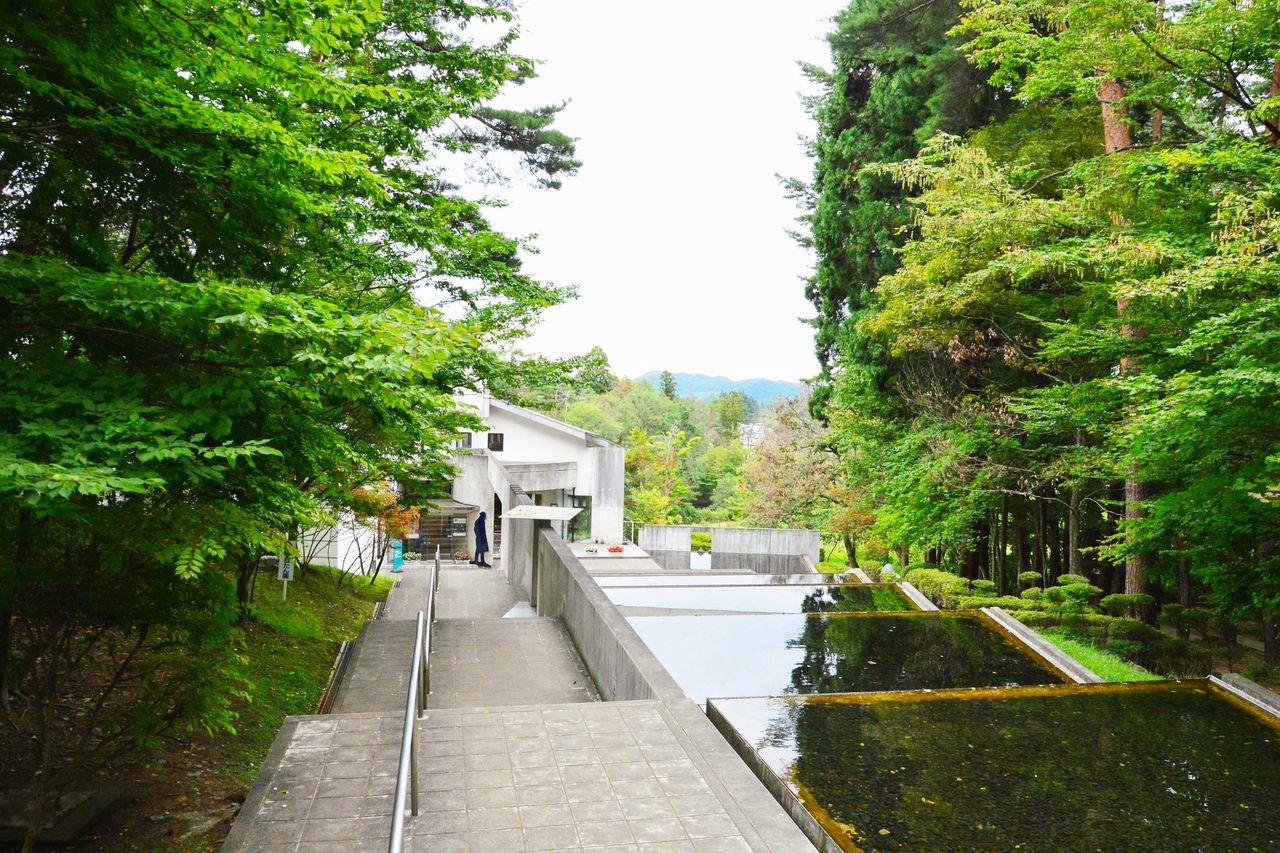
The Ihatov Museum is at the bottom of a flight of stairs surrounded by trees.
The Miyazawa Kenji Ihatov Museum is a center for information interchange among fans and researchers of Miyazawa’s works. It is located about 10 minutes’ walk downward across Polan Square from the Miyazawa Kenji Memorial Museum. The Nansha Kadan, a sundial flowerbed based on a design by Miyazawa, blooms with lovely seasonal flowers in Polan Square.
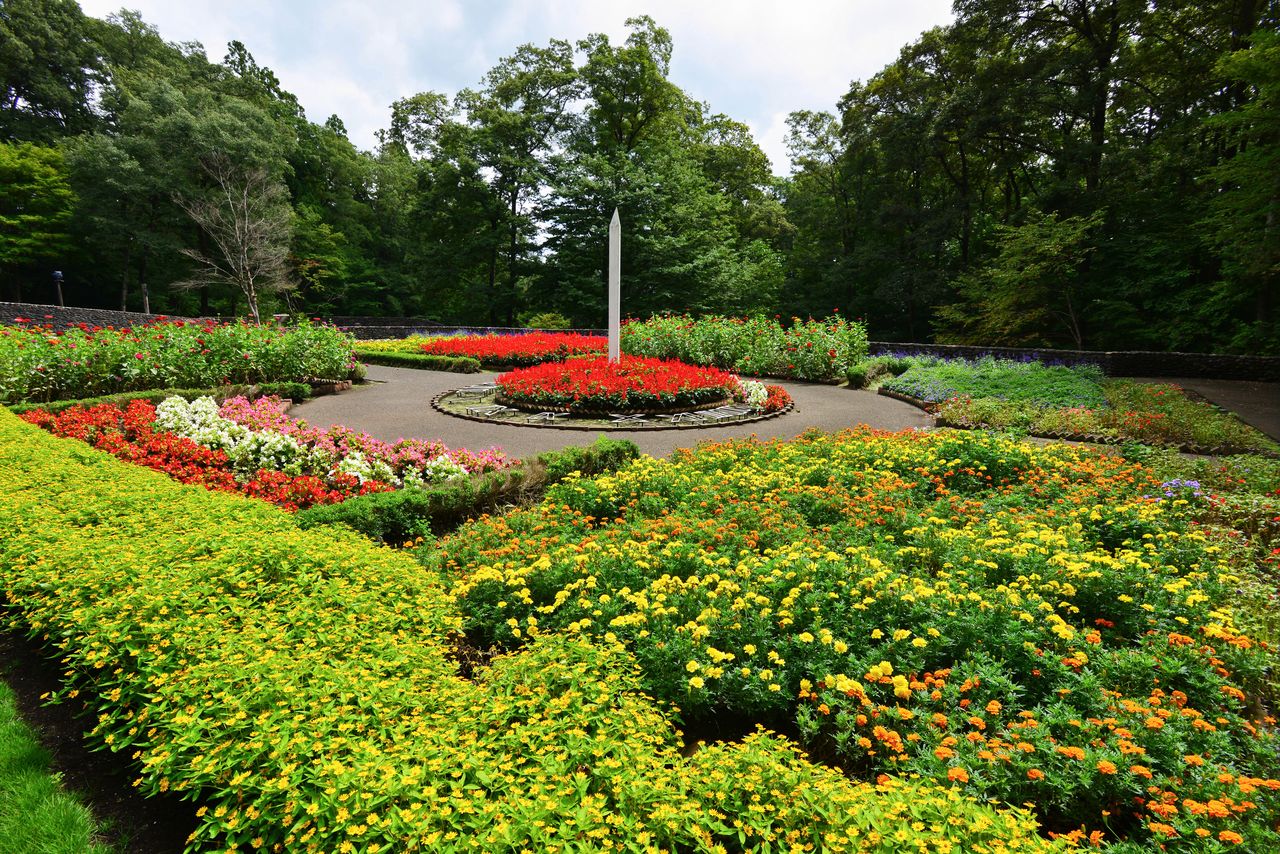
Designed by Miyazawa, the Nansha Kadan blooms with colorful flowers.
The first floor of the building offers halls and exhibit rooms where lectures, stage plays, concerts, and other presentations connected with Miyazawa and Hanamaki take place. In addition to Miyazawa’s collected works, the library on the second floor also houses documents sure to please serious enthusiasts, including the author’s research papers and newspaper clippings about him and his activities. It’s the perfect place to become better informed about the author.
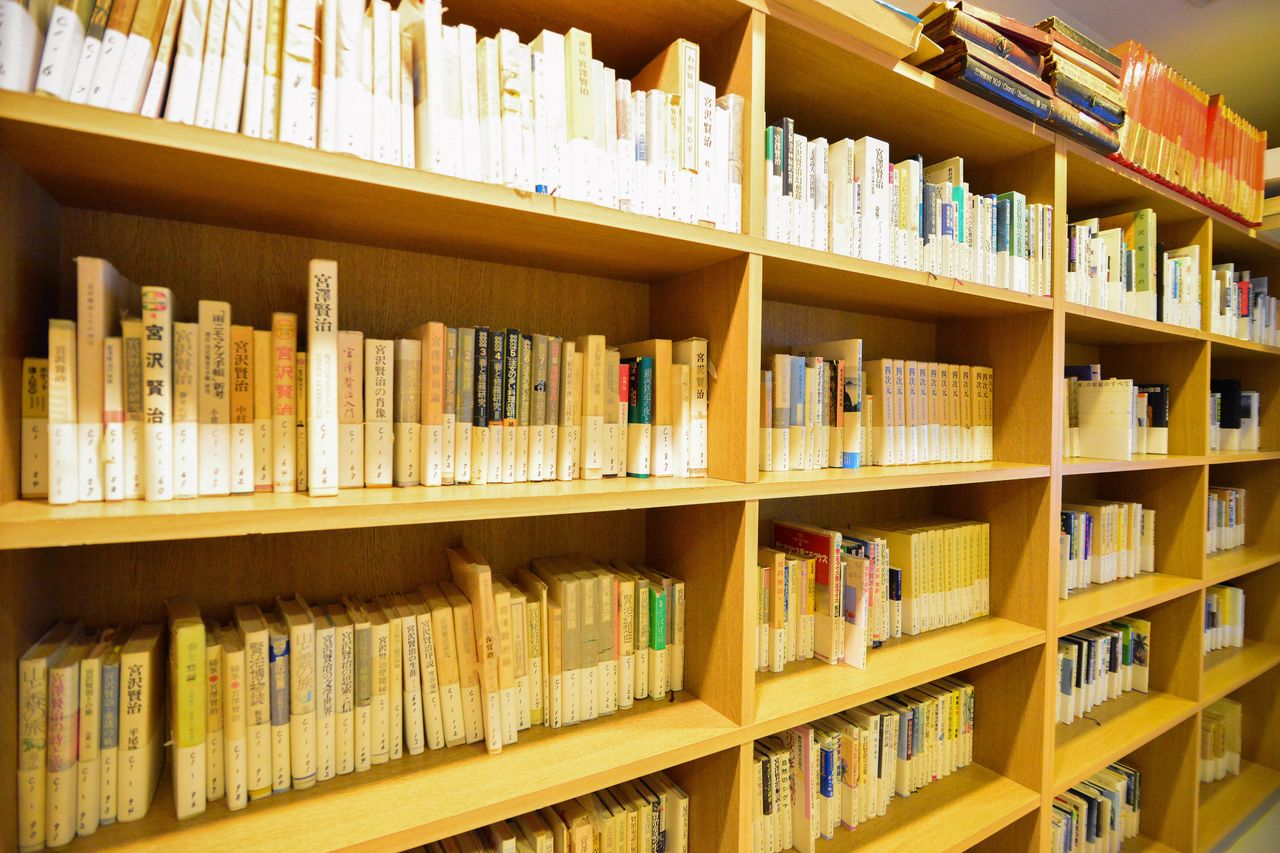
Library shelves on the second floor of the Ihatov Museum stock all manner of publications pertaining to Miyazawa.
Most of Miyazawa’s children’s stories are available for purchase in Japanese and other languages at the gift shop on the first floor. Interested readers can compare the translations with the originals. The gift shop also has a variety of branded souvenirs for sale, and admirers of Miyazawa’s works gather for talk and refreshments in the nearby café.
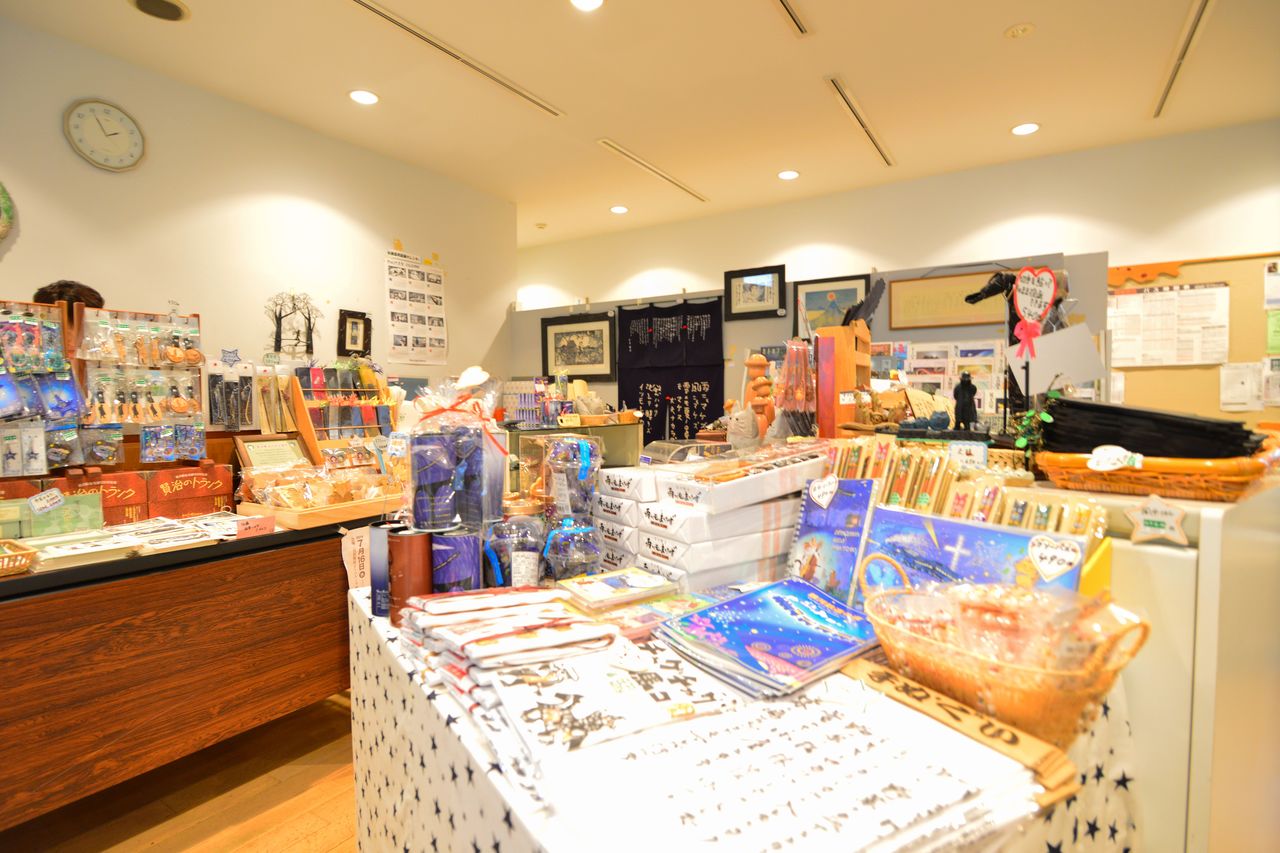
The Cat’s Office gift shop sells Miyazawa publications and merchandise.
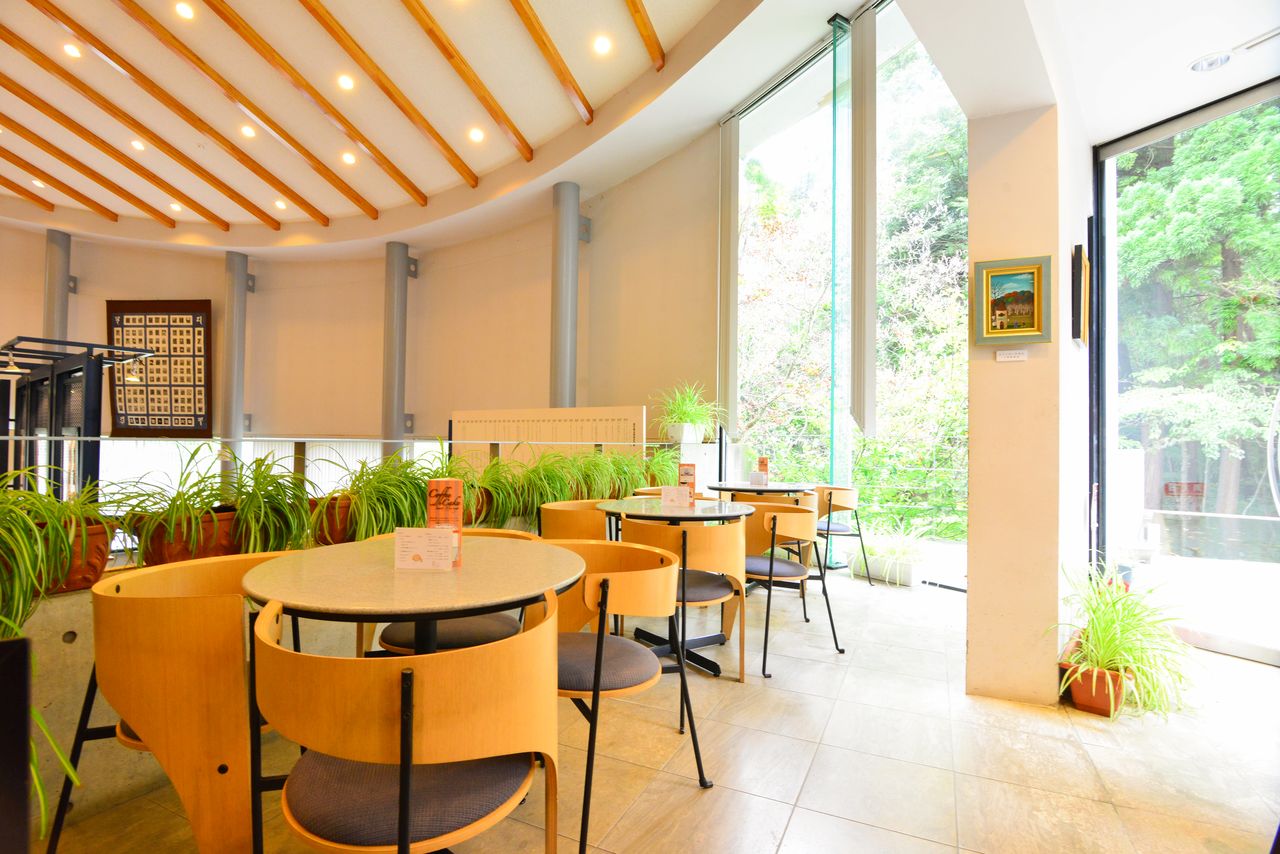
The café is a well-lit place to relax.
DATA
Miyazawa Kenji Ihatov Museum
- Address: 1-1-1 Takamatsu, Hanamaki, Iwate Prefecture
- Access: 2 minutes from JR Shin-Hanamaki Station by Iwateken-kōtsū bus Tsuchisawa line, then 5 minutes’ walk from Miyazawa-Kenji-Kinenkan-guchi bus stop
- Tel.: 0198-31-2116
- Hours: 8:30 am to 4:30 pm (closed at 5:00 pm)
- Open every day except December 28–January 1
- Admission free
- Multilingual Information:
- Facility signage in English and Simplified and Traditional Chinese.
An Immersive Experience: Miyazawa Kenji Dōwa Mura
Located about 10 minutes’ walk north on National Highway 456 from the Ihatov Museum, the Miyazawa Kenji Dōwa Mura offers an opportunity to learn about the stories written by the author while experiencing the settings that he created in those stories. Visitors will know they are close when they start hearing music inspired by Miyazawa’s poetry and onomatopoeia. At the “Ginga Station” entrance is an arch painted with murals giving an illusory sense of outer space, drawing visitors right into the author’s world.
Facilities and monuments recreating the settings of Miyazawa’s children’s stories are scattered here and there throughout this expansive village. It is as though one has stumbled into a dreamland of the author’s own making.
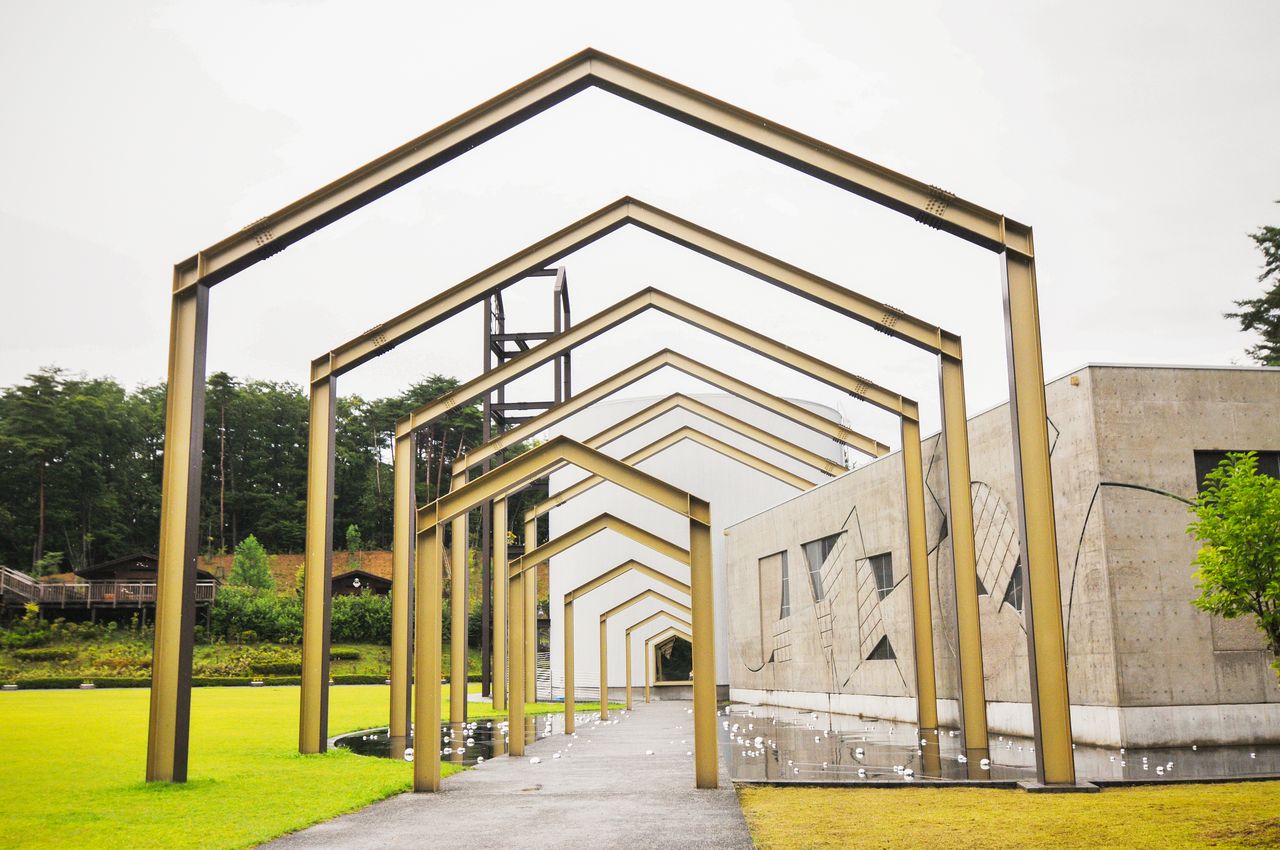
This path leads to Kenji’s School, the main facility of the Miyazawa Kenji Dōwa Mura.
One place not to be missed is Kenji’s School. The first room visitors encounter upon entering the building is the Fantastic Hall, an artistic space with white walls, floor, and ceiling wherein a large tree is depicted as growing in which a night sky and a telephone pole have been painted. There are four other rooms which help visitors gain a sense of the author’s imagination, including an outer space room with red and blue lights twinkling as though in outer space, and a sky room with a video of the city of Hanamaki scrolling beneath one’s feet to give the impression of flying through the air.
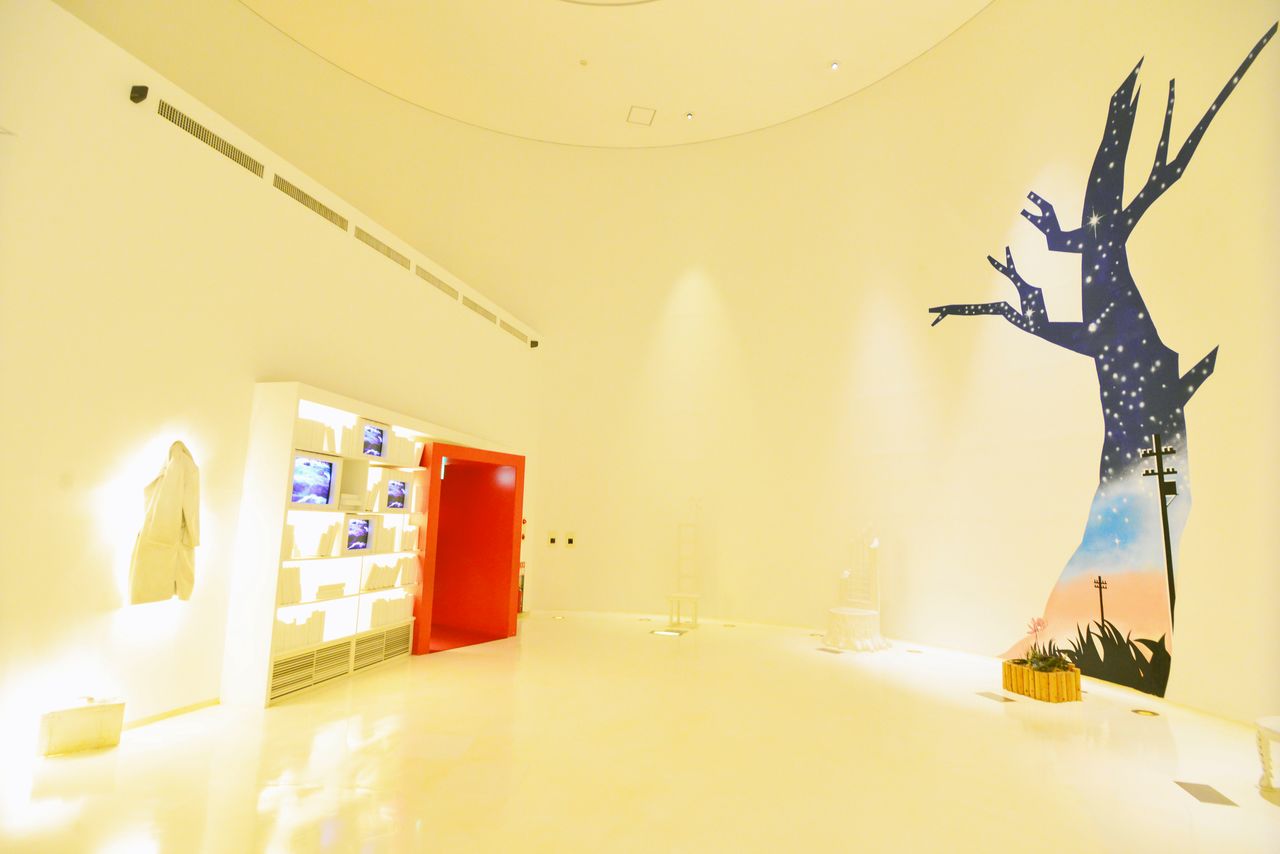
The Fantastic Hall of Kenji’s School.
The five log cabins that make up Kenji’s Classrooms present Miyazawa’s works grouped into five areas, including animals, plants, and stars. The Classroom of the Stars has displays of art objects, signage, and associated works all arranged with constellations as a conceptual theme. Visitors can have a better understanding of Miyazawa’s point of view by reading the stories of the constellations and seeing the plants and animals which the author used in his works.
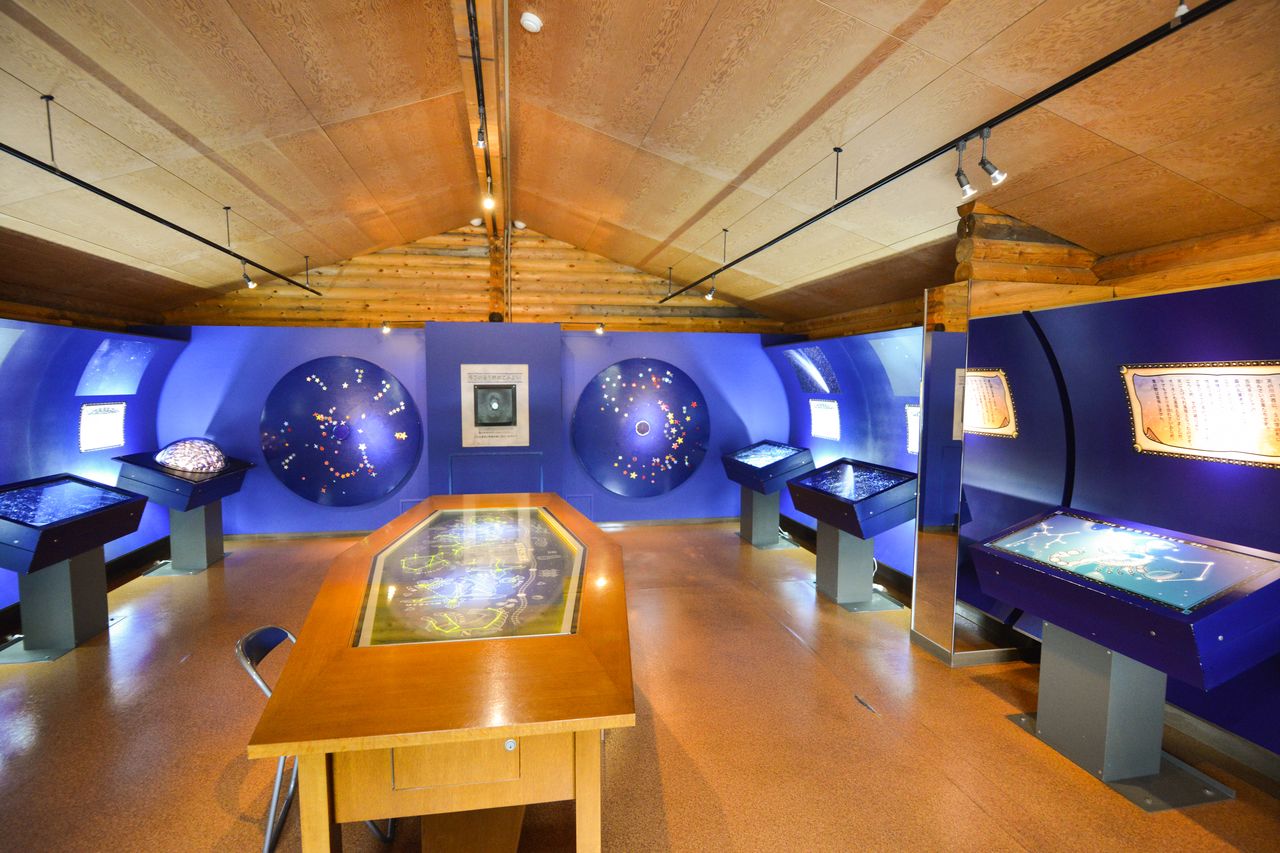
The Classroom of the Stars offers Miyazawa stories associated with constellations and other heavenly bodies.
The gift shop stocks merchandise in motifs based on Miyazawa’s children’s stories as well as souvenirs of Hanamaki. One popular gift is Yodaka no Hoshi, a snack made of dark molasses poured over karintō (small sugar-coated fried-dough biscuits). Miniature book editions of Miyazawa’s children’s stories and poetry that fit in one hand can be easily carried while traveling, making them perfect for reading on the return trip.
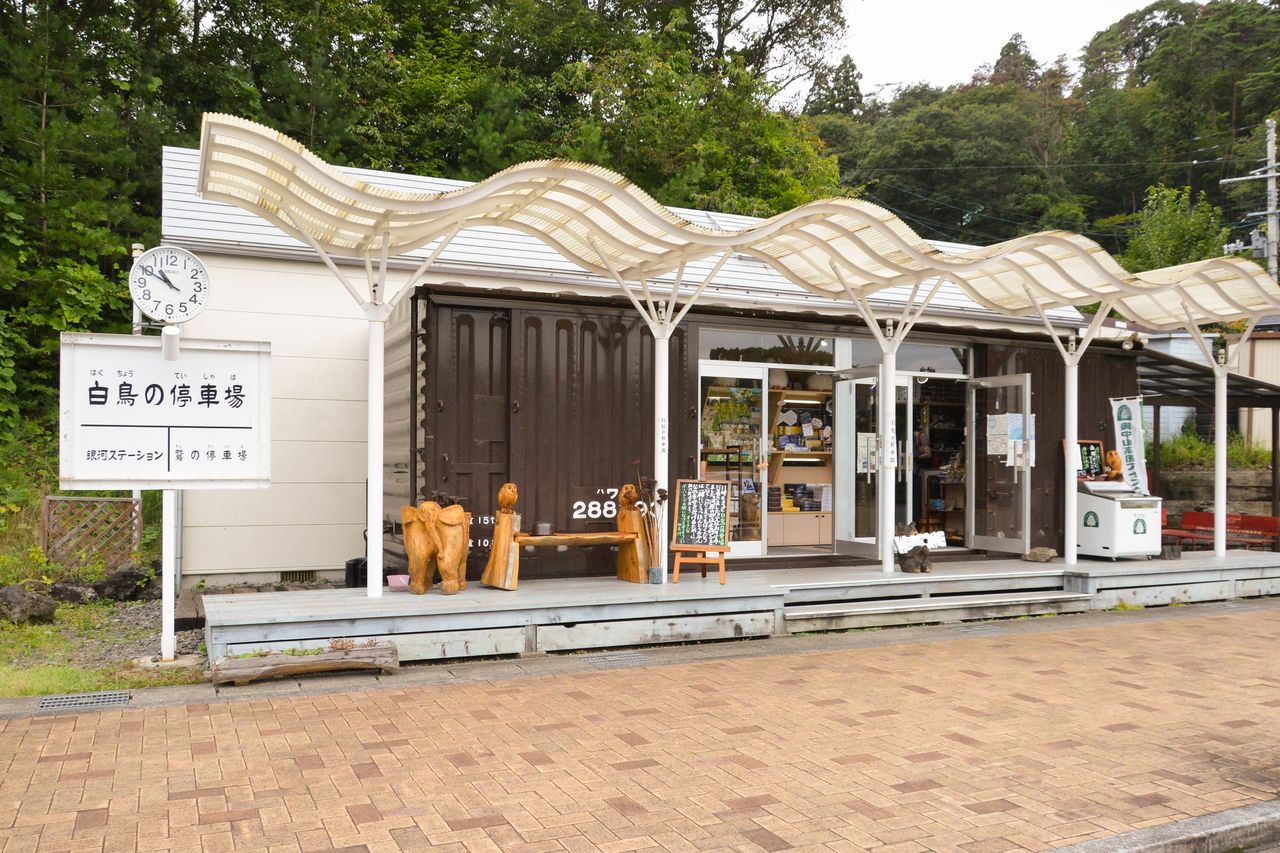
The gift shop is patterned on Swan Station, from Ginga tetsudō no yoru.
DATA
Miyazawa Kenji Dōwa Mura
- Address: 26-19 Takamatsu, Hanamaki City, Iwate Prefecture
- Access: Approx. 5 minutes from JR Shin-Hanamaki Station by Iwateken-kōtsū bus Tsuchisawa line, then a short walk from Miyazawa-Kenji-Kinenkan-guchi bus stop
- Tel.: 0198-31-2211
- Hours: 8:30 am to 4:30 pm
- Open year-round
- Admission: Free to enter (Kenji’s School Admission: ¥350 for adults, ¥250 for high-school and college students, ¥150 for elementary and junior high school students)
- Multilingual Information:
- Pamphlets available in English, Simplified and Traditional Chinese, and Korean
- Facility Signage provided in English, Simplified and Traditional Chinese, and Korean
- English, Chinese, and Korean-speaking guides available
Nearby Attraction: English Coast
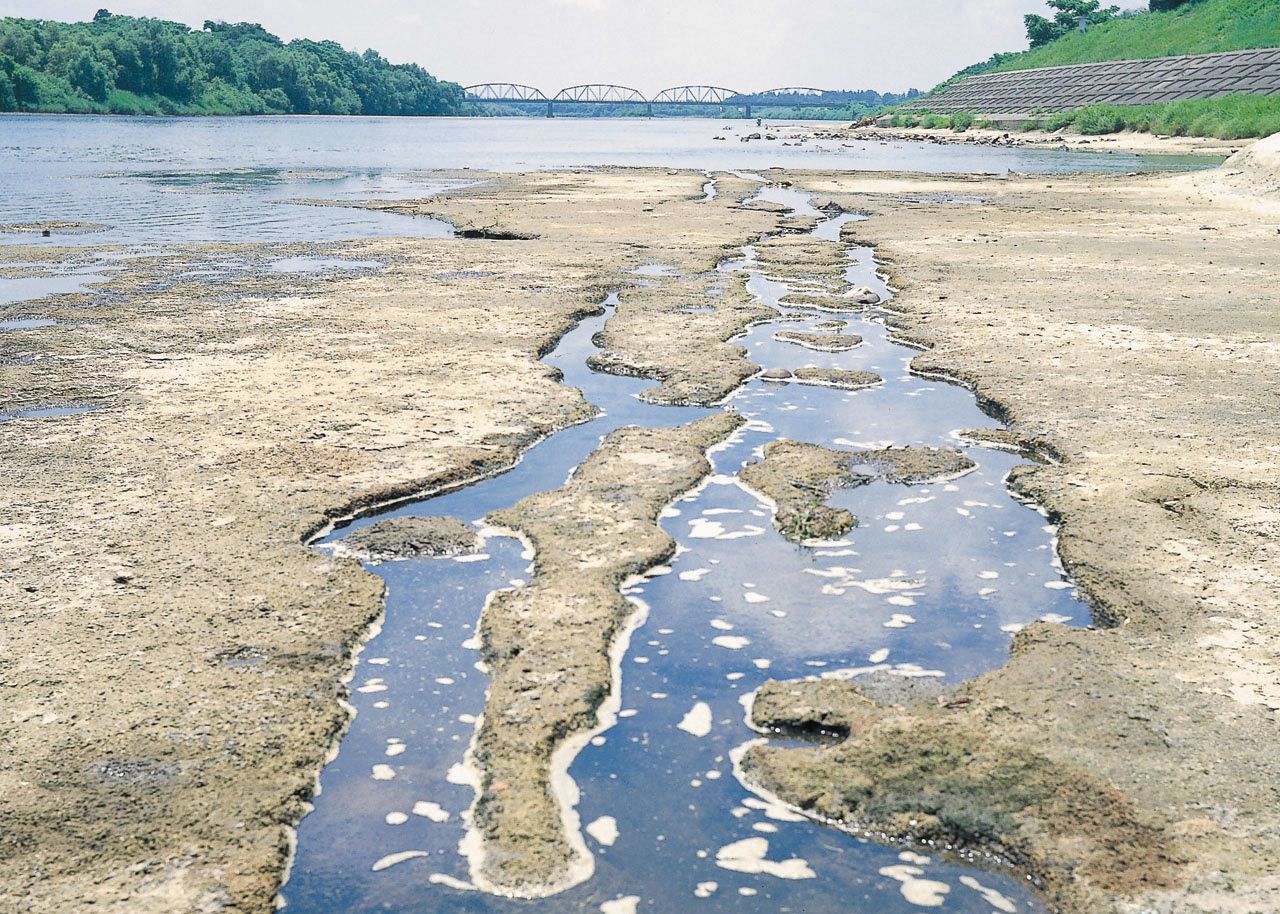
This remarkable sight can only be experienced during periods of drought. (Courtesy of the Iwate Tourism Association)
This coastline is not on any ocean. Rather, upon seeing the west bank of the Kitakami River, when a mudstone layer of the riverbed was exposed during a drought, Miyazawa, who was well-versed in geology, dubbed it the “English Coast.” He explained that the sight gave him the impression of walking along the White Cliffs of Dover. Reading the short story collection Igirisu kaigan (English Coast), which includes this incident as the title story, will help one understand just how impressed he was; he frequently visited this locale with his students during his teaching career.
As of this writing, the water level in the river is maintained by a dam, making it difficult to have the same experience as the author did in his day. On September 21, the anniversary of Miyazawa’s death, the spillways are closed, re-creating this English Coast effect.
DATA
- Address: Kamikobunato, Hanamaki, Iwate Prefecture
- Access: Approx. 6 minutes from JR Hanamaki Station by Iwateken-kōtsū bus Ōhasama-hanamaki line, then 5 minutes’ walk from Igirisu-kaigan bus stop
- Tel.: 0198-24-2111 (Hanamaki City Tourism Section)
(Originally written in Japanese. Reporting and text by Shoepress. Banner photo: A stream flows through grounds surrounded by a grove of trees. Courtesy of the Iwate Tourism Association.)
tourism Iwate literature gallery Hanamaki museums Miyazawa Kenji